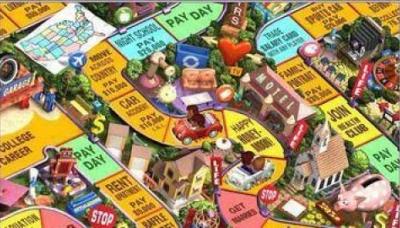The Game of LIFE for the PC and PS1 is a virtual adaptation of the classic family board game.
Gameplay
The Early-game
The Game of LIFE plays near identically to its cardboard and plastic predecessor. A turn begins by "spinning" the spinner The player than moves spaces according to the spun number (1-10). At the beginning of the game players have an option to either go to or get a . The Main difference between the two is how the player gets to choose their career. If the play skips college they select one of 3 buttons which selects them a random career, they are then given three random options for a salary anywhere from $20,000 to $100,000 in increments of $10,000. If a player chooses to go to college they must traverse extra spaces. At the end of college the player is given the option of one of three randomly selected jobs that are visible to the player. They then select 3 of 10 salary options, and then get to choose the option they prefer($20,000 to $100,000.) A players job doesn't change gameplay much, but their are some spaces that if landed on require the player to pay another player that has the specified job on the space. Also, If a player selects the career, they are paid money every time another player spins a 10 for speeding.
The Mid-game
LIFE's mid-game consists of spinning and moving around the board trying to earn as much money as possible and reach the end as quick as possible. All spaces have some sort of interaction with the player. There are a few though that are important to the game, and cause the player to halt when they arrive. The spaces included getting and buying a house. There are pay-day spaces scattered around the board and whether the player passes it or lands on it they are awarded their previously determined salary. There are also spaces for having a baby, having twins, and adopting a baby, these spaces however, do not halt your progress like other family milestone spaces. Each space in the game is usually accompanied by a goofy animation, cartoon or hit-and miss jokes (mostly misses though.) Some space are supposed to represent milestones in one's life, such as a trip to the Grand Canyon or writing a book. These spaces award the player a LIFE tile, an object that consists of a random amount of money.
The End-game
LIFE's end consists of the players hanging up their boots and retiring. When a player retires they select their neighborhood and then spin in effort to receive bonus money. Their are two options of retirement communities, Countryside Acres and Millionaire Estates. Countryside acres has less opportunity to lose money with retirement, but the most the can expect to be awarded is $45,000. Millionaire estates has many more chances to lose money. Players who retire here could either lose up to $150,000 or win up to $200,000. Once all the players are retired, each player's LIFE tiles are revealed and the money associated with each tile is given to its respective player. The player with the most money after it all is the winner.

